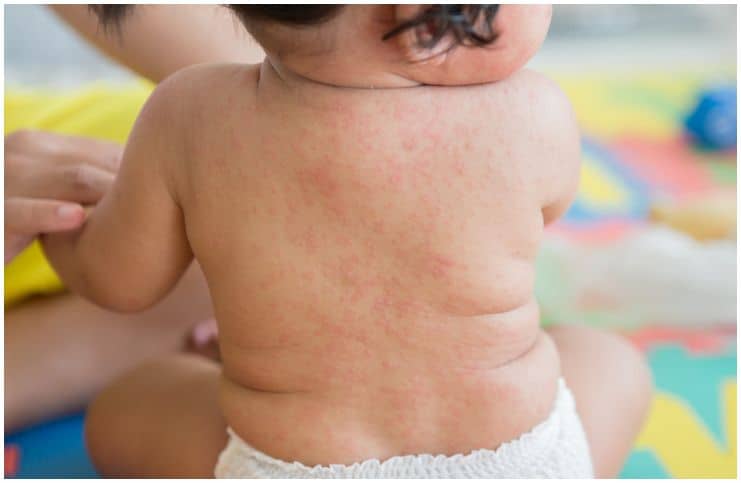Learn what are the differences between these two childhood diseases:
Roseola Infantum
It is a common disease of childhood that is caused by primary infection with human herpesvirus 6 (HHV-6).
An estimated 90 percent of cases occur in children under 2 years old. Roseola occurs equally in boys and girls.
The condition is known by many other names, like – Three-Day Fever, Sixth Disease, or Rose Rash.
Fifth Disease
It is a viral disease that commonly results in a red rash on the legs, arms, and cheeks. It is also called slapped cheek disease or erythema infectiosum.
This infection mainly occurs during spring and winter, most often in children between 5-14 years of age.
The clinical illness was first described in 1896 and named the fifth disease because of its 5th position in the numerical classification of 6 childhood illnesses that are associated with rashes.
An individual commonly gets sick with slapped cheek disease within 4 to 14 days after getting infected with parvovirus B19.
Symptoms
Roseola
Common symptoms may include:
- decreased appetite;
- high fever, which starts abruptly and may reach 105 degrees F. Fever lasts 3 to 5 days and then abruptly goes away;
- swelling of lymph nodes;
- as the fever decreases, a pink rash starts to appear on the trunk and then spreads to the arms, face, and legs;
- swelling of the eyelids;
- irritability.
Note – in normal circumstances, the rash goes away in a few hours or in about 2 or 3 days.
Typically, this rash lasts no more than 10 days.
Occasionally, children have febrile convulsions during a fever. This is not usually serious, but you should see your healthcare provider.
Fifth Disease
Common symptoms include:
The first signs of slapped cheek disease are mild flu- or cold-like symptoms, including:
- fatigue;
- a runny or stuffy nose;
- headache;
- sore throat;
- low-grade fever.
Within 7 to 10 days, a rash can develop starting on the face. Occasionally, a lace-like rash, frequently itchy, can occur on the body and it involves the buttocks, arms, and thighs.
The rash may disappear and then reappear after sun exposure, heat, or after exercising for weeks. But, some children can be infected without ever exhibiting these symptoms.
By the time the rash appears, infected children are no longer contagious and may attend daycare or school.
While adults don’t usually develop a rash, they may develop swelling or pain in the joints of their wrists, knees, hands, and ankles.
Complications
The only complications associated with the sixth disease are seizures or mononucleosis-like syndrome.
Pregnant women who develop slapped cheek disease may potentially develop problems with the fetus and should discuss their case with their healthcare professional.
People with slapped cheek disease who are immune-compromised have an increased risk for the development of complications than people with a healthy immune system.
In children with beta-thalassemia (a blood disorder that reduces the production of hemoglobin), sickle cell disease (a disorder of the blood caused by an inherited abnormal hemoglobin), and hereditary spherocytosis (a condition that affects red blood cells), slapped cheek disease can cause these conditions to become suddenly much worse.
Causes
Roseola
It is caused by a type of herpes virus that is spread when a child breathes in droplets that contain the virus after an infected person sneezes, coughs, laughs, or talks.
The virus can enter the human body through the mouth and nose. Scientists believe that it takes approximately 5 to 15 days to develop the disease after having been infected by HHV-6. In rare occasions, HHV-7 can also cause the infection.
The sixth disease can be infectious before the rash appears; therefore, it can easily spread through communities and daycare centers before any parent knows the child is sick.
Fifth Disease
It is caused by human parvovirus B19 that is transmitted mainly by respiratory secretions, however, it can also be spread by contact with infected blood as well as from an infected pregnant woman to a developing fetus.
Diagnosis
Healthcare providers confirm a diagnosis of the Roseola Infantum disease by the telltale rash or by a blood test to check for antibodies to HHV-6.
Doctors can diagnose slapped cheek disease either by a blood test that can determine if you are immune to parvovirus B19 infection or by seeing a “slapped cheek” rash on a sufferer’s face.
Treatment
Since roseola is a viral infection, there is no cure for it. Your healthcare provider might recommend giving your child plenty of fluids and acetaminophen to reduce fever.
The fever and joint pain of slapped cheek disease in children usually need no treatment.
But, drinking plenty of water can be helpful to relieve fever.
Prevention
Washing the hands thoroughly is always a good idea since it can help prevent the spread of many infections.
There is no vaccine to prevent these infections.
Roseola vs Fifth Disease – Differences
Roseola is a viral infection that usually affects infants and young children. It is most common in kids under the age of 1 and causes a pinkish-red rash and high fever.
The rash is not itchy. This disease is contagious even if no rash is present. Children with this infection recover fully, usually within 7 days.
The fifth disease is an infection caused by parvovirus B19. Symptoms include fatigue, low fever, joint aches, a “slapped cheeks” rash, and a whole-body rash.
The infection got its name as it was 5th on a list of historical classifications of common rashes in children.
READ THIS NEXT:
33 Interesting Facts About Nucleus
25 Interesting Facts About Golgi Apparatus
Apricot Juice – Nutrition Facts
References https://www.ncbi.nlm.nih.gov/pmc/articles/PMC4267952/ https://pedclerk.bsd.uchicago.edu/page/human-herpes-virus-6-and-roseola https://www.sciencedaily.com/releases/2015/06/150616114249.htm
